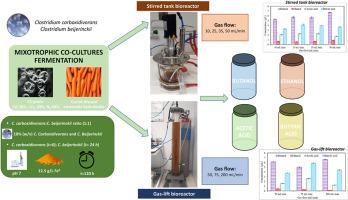C. carboxidivorans和C. beijerinckians在搅拌槽生物反应器和气举式生物反应器中对c1气体和胡萝卜废水解液进行混养共培养发酵
IF 5.8
2区 生物学
Q1 AGRICULTURAL ENGINEERING
引用次数: 0
摘要
目前的研究表明,利用胡萝卜废料的水解物作为共底物和补充Fe0,碳梭菌和beijerinckii梭菌共同培养C1气体(CO和CO2)。比较了搅拌槽式生物反应器(STB)和气举式生物反应器(GLB)两种不同构型生物反应器在不同气体流量下的性能。GLB技术在50 mL/min的气流量下运行,效率更高,在47 h的发酵周期内,丁醇产量高达12.0 g/L,乙酸产量为2.7 g/L,丁酸产量为7.4 g/L。该工艺在t = 33 h时实现了糖和CO的完全消耗,同时最大CO2吸收率为82.4%。因此,气升式生物反应器代表了C. carboxidivorans和C. beijerinckii共同发酵C1气体和胡萝卜废弃水解液的有前途的策略,具有低能量需求,成本效益,设计和操作简单。本文章由计算机程序翻译,如有差异,请以英文原文为准。

Mixotrophic co-cultures fermentation of C1-gases and carrot discard hydrolysate by C. carboxidivorans and C. beijerinckii in stirred tank bioreactor and gas-lift bioreactor
The current study represents the bioconversion of C1 gases (CO and CO2) using co-cultures of Clostridium carboxidivorans and Clostridium beijerinckii, with hydrolysates from carrot discard as a co-substrate and supplemental Fe0. The performance of two distinct bioreactor configurations, a stirred-tank bioreactor (STB) and a gas-lift bioreactor (GLB) was compared under various gas flow rates. The GLB technology, operating at a gas flow of 50 mL/min, proved more efficient, yielding up to 12.0 g/L of butanol, 2.7 g/L of acetic acid, and 7.4 g/L of butyric acid within a 47 h fermentation period. This process achieved complete consumption of sugars and CO, alongside a maximum CO2 uptake of 82.4 % at t = 33 h. Consequently, the gas-lift bioreactor represents a promising strategy for the co-fermentation of C1 gases and carrot discard hydrolysate by C. carboxidivorans and C. beijerinckii, offering low energy requirements, cost-effectiveness, and simplicity in design and operation.
求助全文
通过发布文献求助,成功后即可免费获取论文全文。
去求助
来源期刊

Biomass & Bioenergy
工程技术-能源与燃料
CiteScore
11.50
自引率
3.30%
发文量
258
审稿时长
60 days
期刊介绍:
Biomass & Bioenergy is an international journal publishing original research papers and short communications, review articles and case studies on biological resources, chemical and biological processes, and biomass products for new renewable sources of energy and materials.
The scope of the journal extends to the environmental, management and economic aspects of biomass and bioenergy.
Key areas covered by the journal:
• Biomass: sources, energy crop production processes, genetic improvements, composition. Please note that research on these biomass subjects must be linked directly to bioenergy generation.
• Biological Residues: residues/rests from agricultural production, forestry and plantations (palm, sugar etc), processing industries, and municipal sources (MSW). Papers on the use of biomass residues through innovative processes/technological novelty and/or consideration of feedstock/system sustainability (or unsustainability) are welcomed. However waste treatment processes and pollution control or mitigation which are only tangentially related to bioenergy are not in the scope of the journal, as they are more suited to publications in the environmental arena. Papers that describe conventional waste streams (ie well described in existing literature) that do not empirically address ''new'' added value from the process are not suitable for submission to the journal.
• Bioenergy Processes: fermentations, thermochemical conversions, liquid and gaseous fuels, and petrochemical substitutes
• Bioenergy Utilization: direct combustion, gasification, electricity production, chemical processes, and by-product remediation
• Biomass and the Environment: carbon cycle, the net energy efficiency of bioenergy systems, assessment of sustainability, and biodiversity issues.
 求助内容:
求助内容: 应助结果提醒方式:
应助结果提醒方式:


